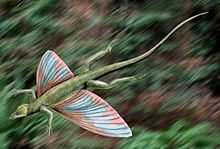Weigeltisauridae
| Weigeltisauridae Temporal range: Late Permian - Early Triassic | |
|---|---|
 | |
| Life restoration of Coelurosauravus jaekeli | |
| Scientific classification | |
| Kingdom: | Animalia |
| Phylum: | Chordata |
| Class: | Reptilia |
| Clade: | Neodiapsida |
| Family: | †Weigeltisauridae Kuhn, 1939 |
| Species | |
|
†Coelurosauravus
| |
| Synonyms | |
| |
Weigeltisauridae is a family of gliding neodiapsid reptiles that lived during the Permian period. Fossils of weigeltisaurids have been found in Madagascar, Germany, Great Britain, and Russia. Possible weigeltisaurid fossils have been found in Triassic strata in North America.[1] They are characterized by long rod-shaped bones extending from the torso that most likely supported wing-like membranes.[2][3][4] Similar membranes are also found in several other extinct reptiles such as kuehneosaurids and Mecistotrachelos, as well as living gliding lizards, although each group evolved these structures independently. The gliding membranes in these other groups differ from those of weigeltisaurids in that they are formed by elongated ribs rather than distinct rod-like bones. Weigeltisaurids are also characterized by the large crest-like structures at the back of their skulls, which are lined with spikes formed from bony osteoderms.
In addition to gliding membranes, weigeltisaurids have several other adaptations to an arboreal or tree-living lifestyle. Their skeletons are lightened by large air spaces within the bones. The region of the spinal column that connect to the hip, called the sacrum, is formed by three vertebrae rather than two as in most early reptiles, which would have stabilized the skeleton from stresses experienced while climbing. The limb bones of weigeltisaurids have well-developed joint surfaces and prominent ridges for the attachment of muscles, an indication that their limbs were strong enough to support vertical climbing up tree trunks. The shaft of the humerus or thigh bone is twisted, allowing for greater flexibility of the hind limbs. The long finger and strongly recurved claw bones with large attachment points for flexor muscles may be adaptations for clinging to tree bark.[1]
The wide distribution of weigeltisaurid fossils suggests that the group underwent a global dispersal in a relatively short amount of geologic time. The widespread dispersal of weigeltisaurids may be attributed to their radiation into an arboreal, insectivorous ecological niche previously unoccupied by land vertebrates.[1]
References
- ↑ 1.0 1.1 1.2 Bulanov, V. V.; Sennikov, A. G. (2010). "New data on the morphology of permian gliding weigeltisaurid reptiles of Eastern Europe". Paleontological Journal 44 (6): 682. doi:10.1134/S0031030110060109.
- ↑ "Paleobiology Database".
- ↑ "SpringerLink".
- ↑ Blount, Kitty; Crowley, Maggie; Bada, Kathleen; Malyan, Susan; Sparrow, Giles; Thiro, Rosalyn; Walisiewicz, Marek, eds. (2001, 2008). Encyclopedia of Dinosaurs and Other Prehistoric Life. New York, New York: DK Publishing Special Markets. p. 77. ISBN 978-0-7566-3836-8.
| ||||||||||||||||||||||||||||||||||||||||||||||||||||||||||||||||||||||||||